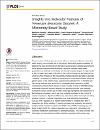Insights into molecular features of venerupis decussata oocytes: A microarray-based study
| Author | Pauletto, Marianna |
| Author | Milan, Massimo |
| Author | De Sousa, Joana Teixeira |
| Author | Huvet, Arnaud |
| Author | Joaquim, Sandra |
| Author | Matias, Domitilia |
| Author | Leitao, Alexandra |
| Author | Patarnello, Tomaso |
| Author | Bargelloni, Luca |
| Available date | 2016-01-14T13:24:27Z |
| Publication Date | 2014-12 |
| Publication Name | PLoS ONE |
| Resource | Scopus |
| Citation | Pauletto M, Milan M, de Sousa JT, Huvet A, Joaquim S, Matias D, et al. (2014) Insights into Molecular Features of Venerupis decussata Oocytes: A Microarray-Based Study. PLoS ONE 9(12): e113925. |
| ISSN | 1932-6203 |
| Abstract | The production of Venerupis decussata relies on wild seed collection, which has been recently compromised due to recruitment failure and severe mortalities. To address this issue and provide an alternative source of seed, artificial spawning and larval rearing programs were developed. However, hatchery-based seed production is a relatively new industry and it is still underdeveloped. A major hurdle in the European clam seed production is the control of spawning and reproduction, which is further hindered by the impossibility of obtaining fertile gametes by gonadal "stripping", as meiosis re-initiation is constrained to a maturation process along the genital ducts. In the present study, oocytes were collected from 15 females and microarray analyses was performed to investigate gene expression profiles characterizing released and stripped ovarian oocytes. A total of 198 differentially expressed transcripts between stripped and spawned oocytes were detected. Functional analysis carried out on these transcripts highlighted the importance of a few biological processes, which are most probably implicated in the control of oocyte competence. Significant differences were observed for transcripts encoding proteins involved in meiosis progression (e.g. dual specificity phosphatase CDC25), WNT signalling (e.g. frizzled class receptor 8, wingless-type MMTV integration site family member 4), steroid synthesis (e.g. progestin and adipoQ receptor family member 3, cytochrome P450-C17), mRNA processing (e.g. zinc finger protein XlCOF28), calcium regulation (e.g. regucalcin, calmodulin) and ceramide metabolism (ceramidase B, sphingomyelinase). This study provides new information on transcriptional profiles putatively associated with ovarian egg infertility, and suggests potential mechanisms regulating early oocyte development in clams. Genes which were differentially expressed between stripped and spawned oocytes might have a pivotal role during maturation process in the gonadal duct and could be interesting targets for further functional studies aiming to make ovarian oocytes fertilizable. |
| Sponsor | EU Project “Research to improve Production of SEED” (REPROSEED: FP 7-KBBE-2009-1-2-11) |
| Language | en |
| Publisher | Public Library of Science |
| Subject | Oocytes Xenopus oocytes Meiosis Gene expression Meiosis |
| Type | Article |
| Issue Number | 12 |
| Volume Number | 9 |
Files in this item
This item appears in the following Collection(s)
-
Earth Science Cluster [188 items ]


